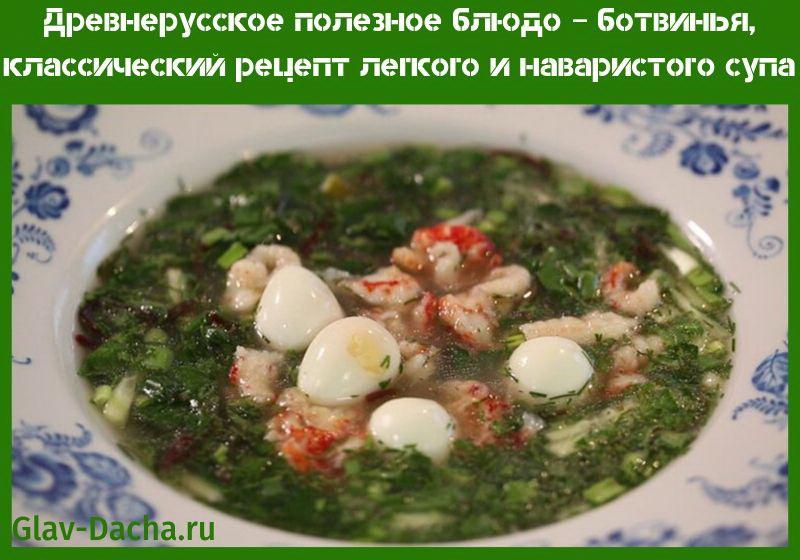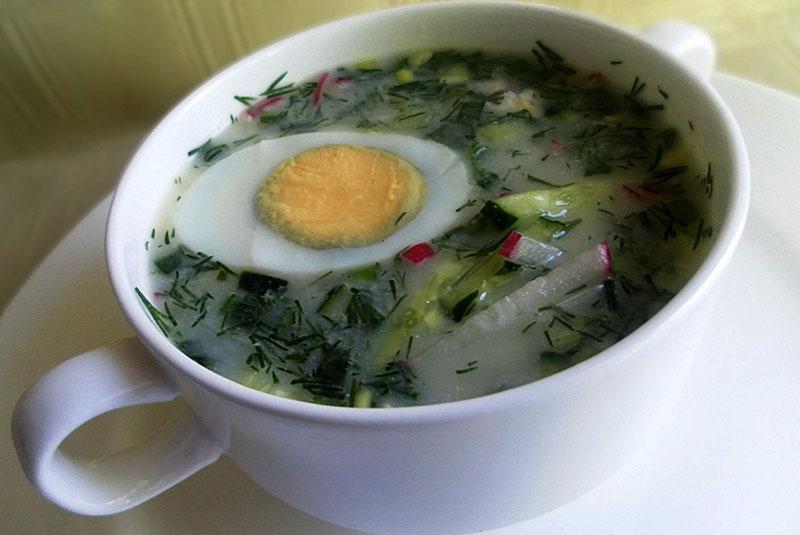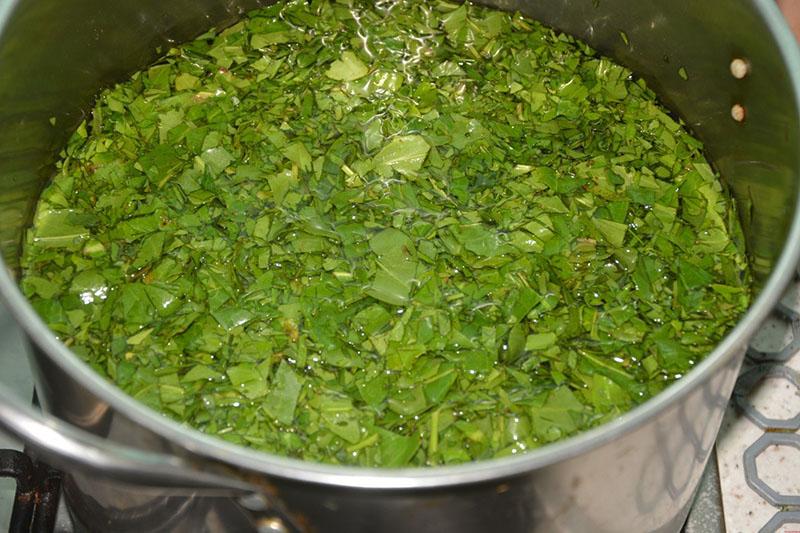An ancient Russian healthy dish - botvinya, a classic recipe for a light and rich soup
 In ancient times, the Slavs had a large number of delicious, vitamin, healthy and at the same time very cheap dishes. One of them is botvinya, the classic recipe of which belongs to ancient Russian cuisine. As the name implies, it was prepared from tops - sorrel leaves, beets with the addition of spinach, nettle, dill, quinoa, parsley. In general, all the greens that only grew in the garden were used. The botvinia was poured with sour kvass. Later, finely chopped radishes, fresh cucumbers, and beets were added to it.
In ancient times, the Slavs had a large number of delicious, vitamin, healthy and at the same time very cheap dishes. One of them is botvinya, the classic recipe of which belongs to ancient Russian cuisine. As the name implies, it was prepared from tops - sorrel leaves, beets with the addition of spinach, nettle, dill, quinoa, parsley. In general, all the greens that only grew in the garden were used. The botvinia was poured with sour kvass. Later, finely chopped radishes, fresh cucumbers, and beets were added to it.
Such a cold common soup quickly gained popularity not only among the poor, but also took its place of honor at the festive and everyday meals of princes and kings. Only for noble people, botvinia was flavored with grated horseradish, later they began to add lemon juice. It was served with boiled or salted fish, various seafood, and crayfish. A device with crushed ice was placed separately on the table for additional cooling of the dish. If earlier, separate cutlery was served for fish, ice and botvinya itself, and they were laid out on different plates, now most often botvinia is served immediately with ice and fish (seafood) in one container.
Incomplete Lean Botvinha, the classic recipe

Incomplete botvinia is considered the easiest classic recipe.
To prepare it you will need:
- a pound of sorrel;
- 5-6 fresh cucumbers;
- 2 liters of kvass;
- a bunch of beet tops;
- green onions, parsley, dill - 50 g each;
- sugar, salt, horseradish, mustard - to taste;
- ice cubes.
Preparing cold soup is pretty straightforward.
Cooking algorithm:
- Sorrel and beet tops are sorted out, washed, put into a saucepan. Pour a little water so that it only covers the greens. Cook in its own juice for about 10 minutes, then grind through a sieve or grind with a mixer (blender).

- Green onions are washed, dried, chopped and mixed with horseradish or mustard, not forgetting to add salt.

- The cucumbers are peeled and finely chopped.

- Transfer the sorrel-beetroot mass into the dish, add onion with horseradish, cucumber slices. All are poured with kvass. Decorated with chopped herbs and served with a bowl of ice.
This is the simplest, most economical, dietary version of botvinia.
Botvinha complete with red fish
 Botvinnik, the recipe for which is presented below, also belongs to the classic, but the soup turns out to be more hearty and rich.
Botvinnik, the recipe for which is presented below, also belongs to the classic, but the soup turns out to be more hearty and rich.
The following products are required:
- red fish (trout, chum salmon, salmon) - 500-600 g;
- kvass (1 liter of dark rye and 1 glass of white okroshechny);
- one fresh cucumber;
- young beets with tops - 4-5 pieces;
- fresh nettle leaves - 200 g;
- fresh radish - 4 pieces;
- 500 g sorrel;
- 100 g green onions;
- salt, sugar, horseradish - to taste;
- crushed ice.
The process of creating this dish is a little more complicated, but in the end it turns out to be a rich and satisfying culinary masterpiece.
Cooking technology:
- The fish is boiled in salted water with peas and bay leaves. Cool, divide into portions.

- Onions are washed, chopped with horseradish, salt and granulated sugar.

- Beet tops, nettle and sorrel are washed (nettles are additionally scalded with boiling water), boiled in a small amount of water for about 5 minutes. Cool and cut into small pieces.

- Beets are peeled, cut into small cubes, stewed in a pan until soft.

- Cut cucumbers and radishes into thin slices or cubes (you can grate).

- Combine all the ingredients in one bowl. Pepper and salt. Okroshechny and dark kvass are combined, seasoned with botvinya.

- Soup, fish and ice are served separately. This is how the beet leaf botvinnik fish soup looks appetizing in the photo.

To make the botvinia more saturated, the fish is boiled with carrots, onions, peppers and other spices.
Then it is taken out, and nettle, tops, sorrel are boiled in the resulting aromatic broth.
Cooking secrets
 Since ancient times, the classic botvinia recipe included only natural ingredients.
Since ancient times, the classic botvinia recipe included only natural ingredients.
Using the following tips, you can prepare the right soup using the ancient Slavic method:
- Kvass. Homemade kvass made on the basis of rye bread or beets is excellent for botvinia. The taste of botvinia largely depends on the choice of an effervescent drink. It is better to cook kvass on your own than to buy no one knows what in the store. There is nothing complicated in this process. The wort is made by steaming the crusts of rye bread with hot water. Leave them for a day in a warm place to ferment. Then add the yeast with granulated sugar and leave to ferment for 6-8 hours. Strain and kvass is ready! In the absence of a homemade drink, you can buy live fermented kvass in store.
- Beet. According to the classic recipe, beets for botvinia are chosen young, always with fresh, non-wilted leaves. It contains the most useful substances, and the tops contain more of them than the roots themselves.
- Additional components. Wild garlic, spinach, quinoa, nettle are added to the soup. Vegetables can be cut into small pieces, strips, cubes, halves, and grated. This is a matter of aesthetic perception.
- Fish. If botvinha is prepared with fish, it is served separately or placed in the middle of a portioned dish. It is better to choose fillets or fish with a minimum of bones for convenience.
- Innings. Decorate botvinnik with chopped herbs, pieces of boiled egg.
Connoisseurs of Slavic cuisine liked the cold beetroot soup with kvass so much that the chefs came up with a hot version. With a rich taste, aromatic, rich botvinia has already become a gastronomic classic, it is prepared with meat, chicken, turkey, and even quail. But the main components are still beet tops and sorrel. Instead of kvass, the classic hot botvinia recipe uses a rich meat broth.
Botvinya is one of the most popular dishes in Ancient Russia. This cold soup is prepared simply, with minimal cost, and there are a lot of vitamins in it, because the freshest products are used and the dish is practically not exposed to heat treatment.
The classic botvinia is an excellent alternative to okroshka on hot summer days. It was not for nothing that she was so popular even on princely and royal tables.